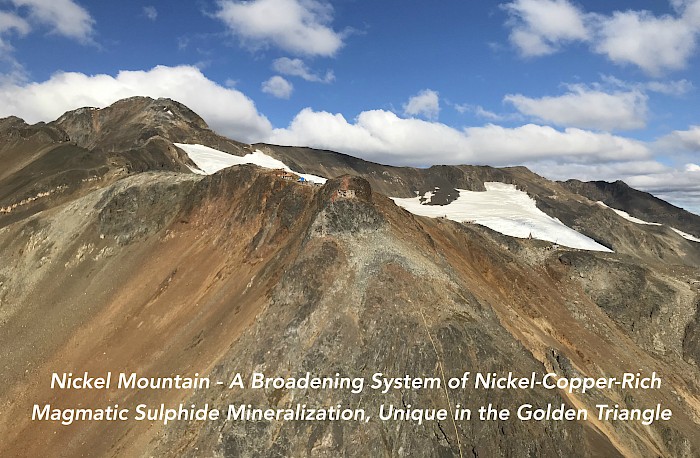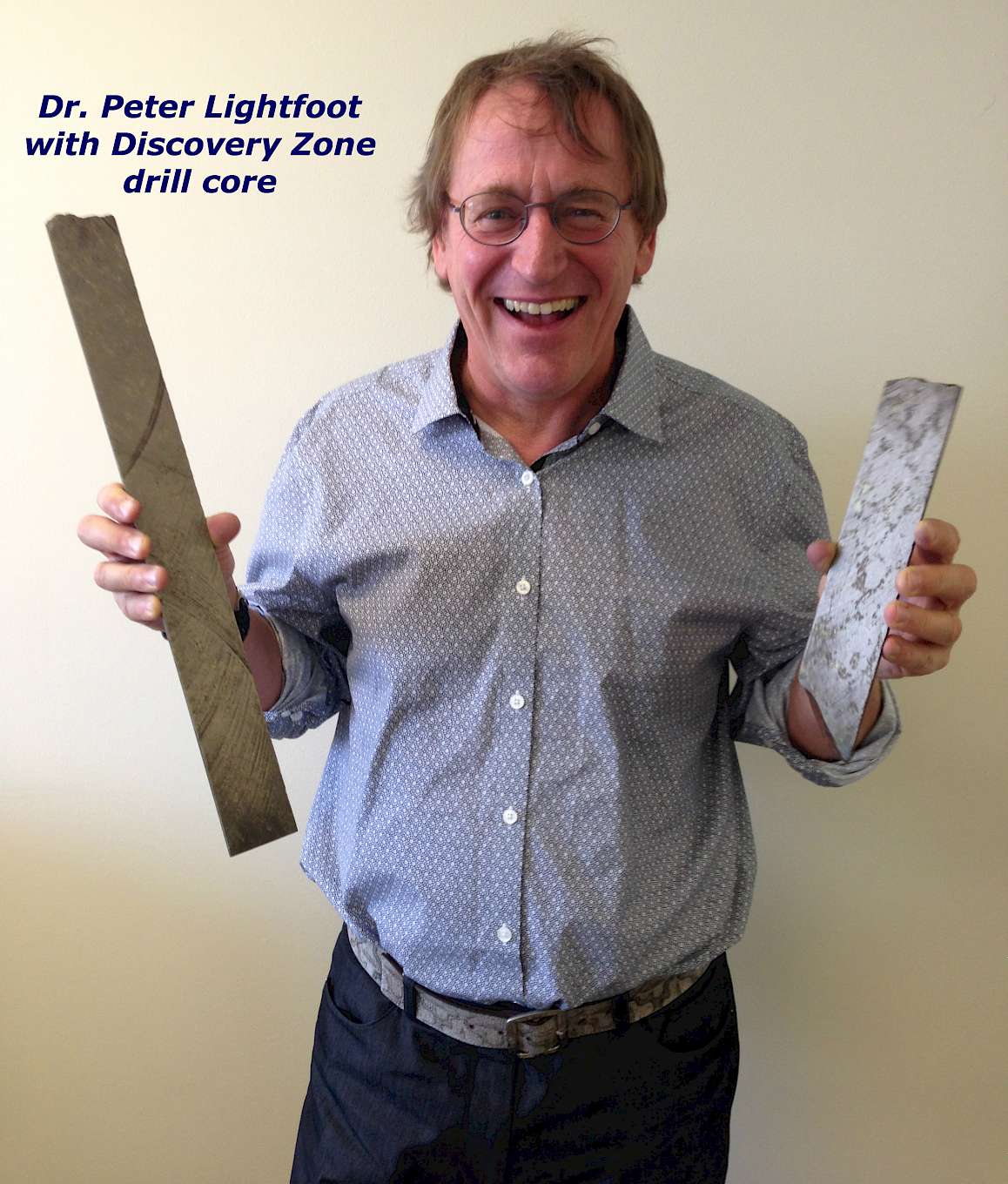| Location | Deposit Type | Commodities | Size | Status |
|---|---|---|---|---|
| Northwestern British Columbia: Eskay Camp | Magmatic Ni-Cu-Co-PGE sulfide | Ni-Cu-Co-PGE | 6,300 ha | 100% Ownership |
E&L Nickel Mountain Project
After decades of exploration in the rugged terrain of Northwest British Columbia’s Golden Triangle, a remarkable discovery was made in the summer of 2017 - Garibaldi Resources’ drill hole EL-17-14 at Nickel Mountain near the historical Eskay Creek deposit intersected a stunning intercept of 8.3% nickel, 4.2% copper, 0.19% cobalt, 1.96 g/t platinum, 4.5 g/t palladium, 1.1 g/t Au and 11.1 g/t silver over 16.75 meters starting just 100.4 meters downhole, within a broader 40.4-meter core length highlighted by 3.9% nickel and 2.4% copper.
The Ni-Cu-Co-PGE-containing sulfides are hosted within a mineralized, variable- and orbicular-textured gabbroic intrusion termed the E&L Intrusion. Massive sulfides associated with the intrusion are emplaced proximal to the E&L Intrusion within sulfur-bearing Hazelton Group sedimentary rocks, particularly mudstone and siltstone.
On February 21, 2019, Garibaldi confirmed an even shallower new zone (Northeast zone) with drill hole EL-18-33 featuring 7.7% nickel and 2.95% copper over 4.8 meters within a broader interval of 49 meters grading 1.34% nickel and 0.89% copper (core length) plus cobalt, platinum, palladium, gold and silver.
In 2019, Garibaldi drilled the longest intercept to date at 18.2 meters of 7.04% nickel and 3.81% copper within a broader intercept of 86.5 meters (65 m to 151.5 m) averaging 1.88% nickel and 1.32% copper (true width estimated at 69.2 meters).
To date, a number of distinct massive sulfide zones have been intercepted close to the contact of the E&L Intrusion: the Lower and Upper Discovery Zones, Northwest Zone, Northeast Zone, and Crevasse Zone. Many of these zones are interpreted as continuous, contact-style mineralization between the E&L Intrusion and the Hazelton Group footwall rocks that contain the intrusion.
In 2020, Garibaldi expanded the footprint of the mineralizing host E&L Intrusion by 650 m down-plunge plunge to the east along the predicted trend of the intrusion. Termed the Eastern Extension Zone and comprised of olivine gabbro and olivine pyroxenite, the rocks intercepted contain disseminated Ni-Cu-Co-PGE mineralization. This zone is interpreted to be the down-plunge extent of the E&L Intrusion, expanding exploration potential for added massive sulfide tonnage at depth and disseminated- to net-textured style mineralization associated with the E&L Intrusion rocks.
The E&L Intrusion represents a suite of gabbro-olivine pyroxenites with distinct trace-element geochemistry classified by world-class experts in nickel-sulfide deposit geochemistry. In 2020, surface sample of boulders with the same geochemical composition, sulfide mineralization, and Ni-tenor as E&L Intrusion rocks at Nickel Mountain were discovered over 800 m west of the E&L Intrusion footprint. This discovery aligns with EM anomalies resulting from Garibaldi’s 2017 VTEM survey over Nickel Mountain, and more recently, Garibaldi’s 2021 ZTEM survey which shows distinct, low-resistivity/high-conductivity responses trending towards the suspected source of the gabbro boulders. This new target, termed E&L West, has potential to expand the footprint of Ni-Cu-Co-PGE mineralization away from existing mineralized zones and adds to an exciting number of magmatic Ni-Cu-Co-PGE and hydrothermal Au-Cu targets to be investigated in the coming 2022 season.
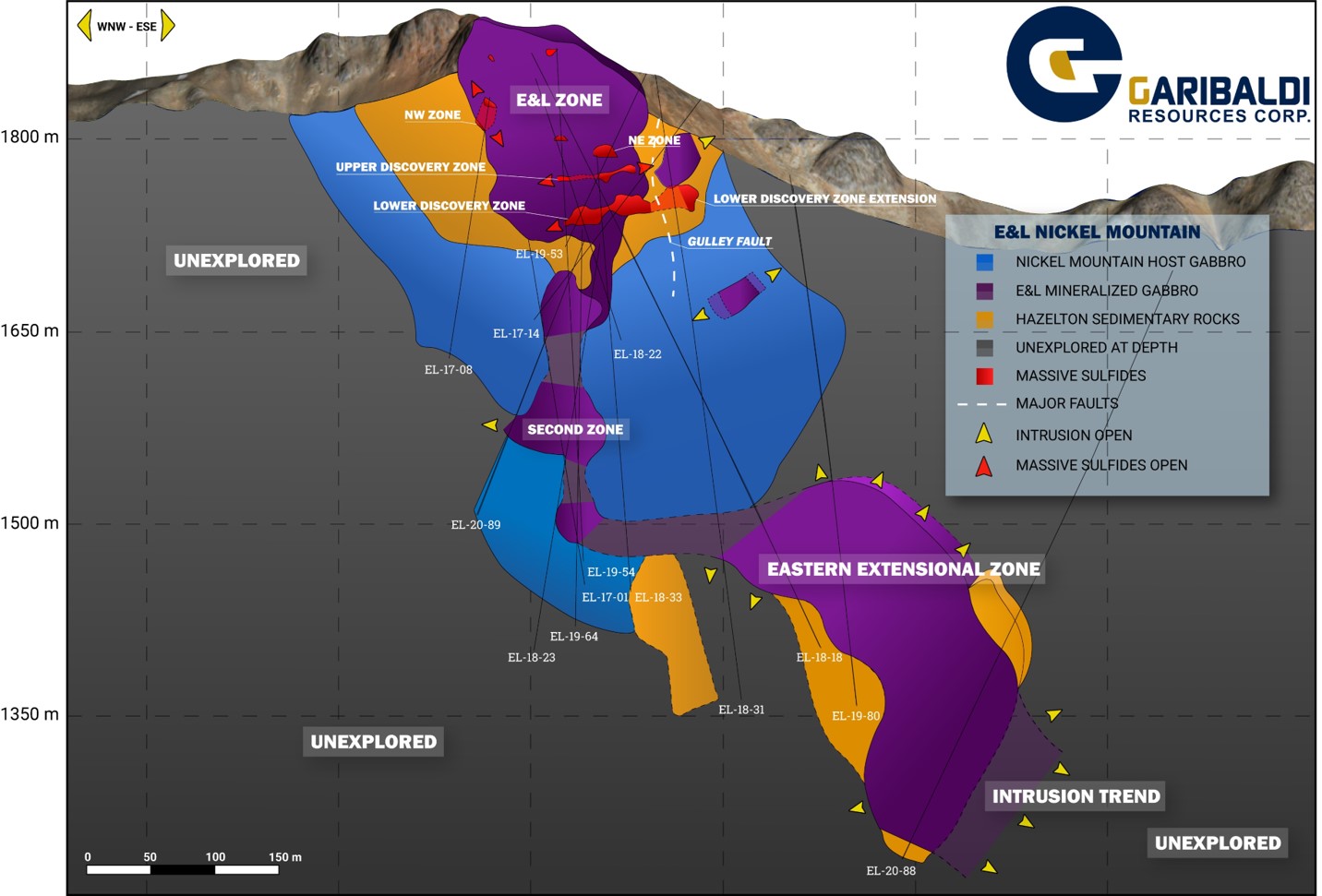
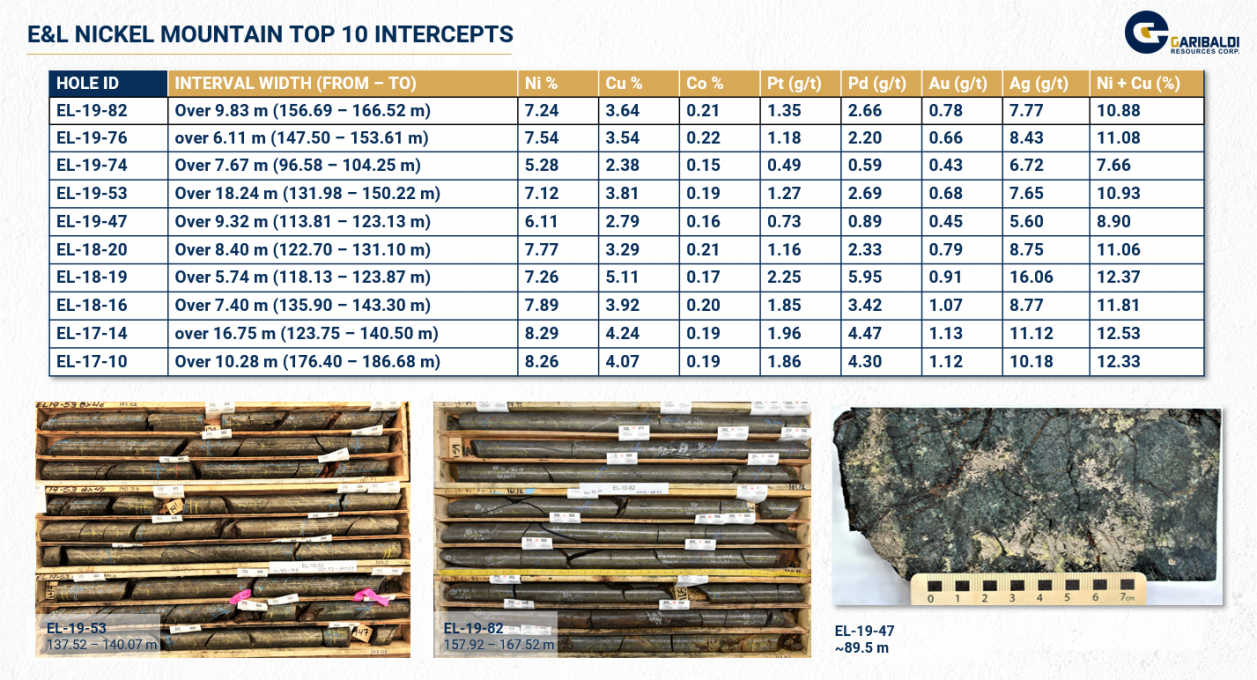
Why Nickel?
Magmatic nickel-copper-rich massive sulphide deposits are a rare breed. As the demand for electric vehicles and batteries intensifies, they are becoming more valuable than ever. Due to purity and dissolvability constraints, Class 1 nickel (99.8% Ni) is required for production of automotive batteries. Nickel-sulfide deposits are a class of deposits with ores that produce Class 1 nickel, the alternative being using lower-purity ores that represent a large capital investment to make them amenable to Class 1 nickel. Nickel-sulfide deposits in well-established mining regions have been significantly depleted; therefore, new Ni-sulfide discoveries are critical to meet future EV battery production demands. The nickel-sulfide mineralization at E&L Nickel Mountain is amenable to a Class 1 nickel product.
McKinsey & Company – The future of nickel: A class act; Basic Materials Nov 2017 Nicolo Campagnol, Ken Hoffman, Ajay Lala, Oliver Ramsbottom
Nickel Sulfide Ores and Impact Melts – Origin of the Sudbury Igneous Complex. 2017. Elsevier, Peter C. Lightfoot
Grade is King!
The Eskay Camp is known for its spectacular grades. Discovered in the late 1980’s, the Eskay Creek mine northeast of Nickel Mountain produced approximately 3.3 million ounces of gold and 160 million ounces of silver at average grades of 49.5 g/t Au and 2,406 g/t Ag. It was once the world’s highest-grade gold mine and the fifth-largest silver mine by volume. In 2017 commercial production began at the high grade Brucejack Mine to the southeast of Nickel Mountain. Brucejack features Proven and Probable Reserves of 15.6 million tonnes grading 15.6 g/t Au and 11.7 g/t Au (refer to Dec. 14, 2018, Pretium news release), making it one of the highest grade gold mines in the world. In late 2021 Brucejack was acquired by Australian mining giant Newcrest for $3.5 billion.
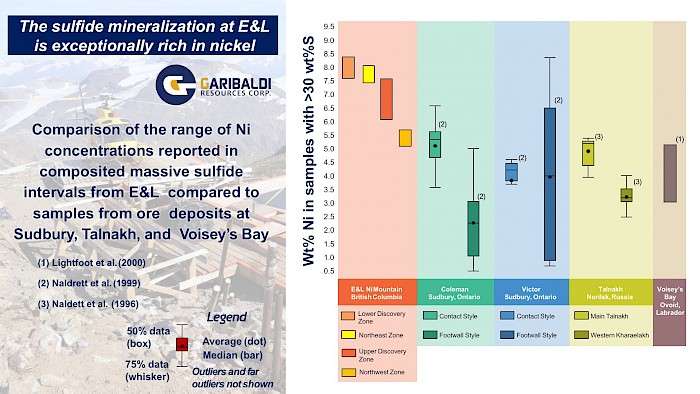
Location - Ni Potential in the Heart of BC’s Golden Triangle
The prolific Eskay Camp has delivered world class discoveries such as Eskay Creek (gold-silver-rich VMS), Snip (gold), KSM (porphyry) and Brucejack (gold), but Garibaldi’s successful reinterpretation of the Eskay Rift in 2016-2017 proved to be a game-changer for the district and the broader Canadian Cordillera. The Golden Triangle’s first magmatic nickel-copper-rich massive sulphide system has generated a new wave of exploration and interest in Northwest British Columbia, setting the stage for future magmatic Ni-Cu-Co-PGE discoveries.
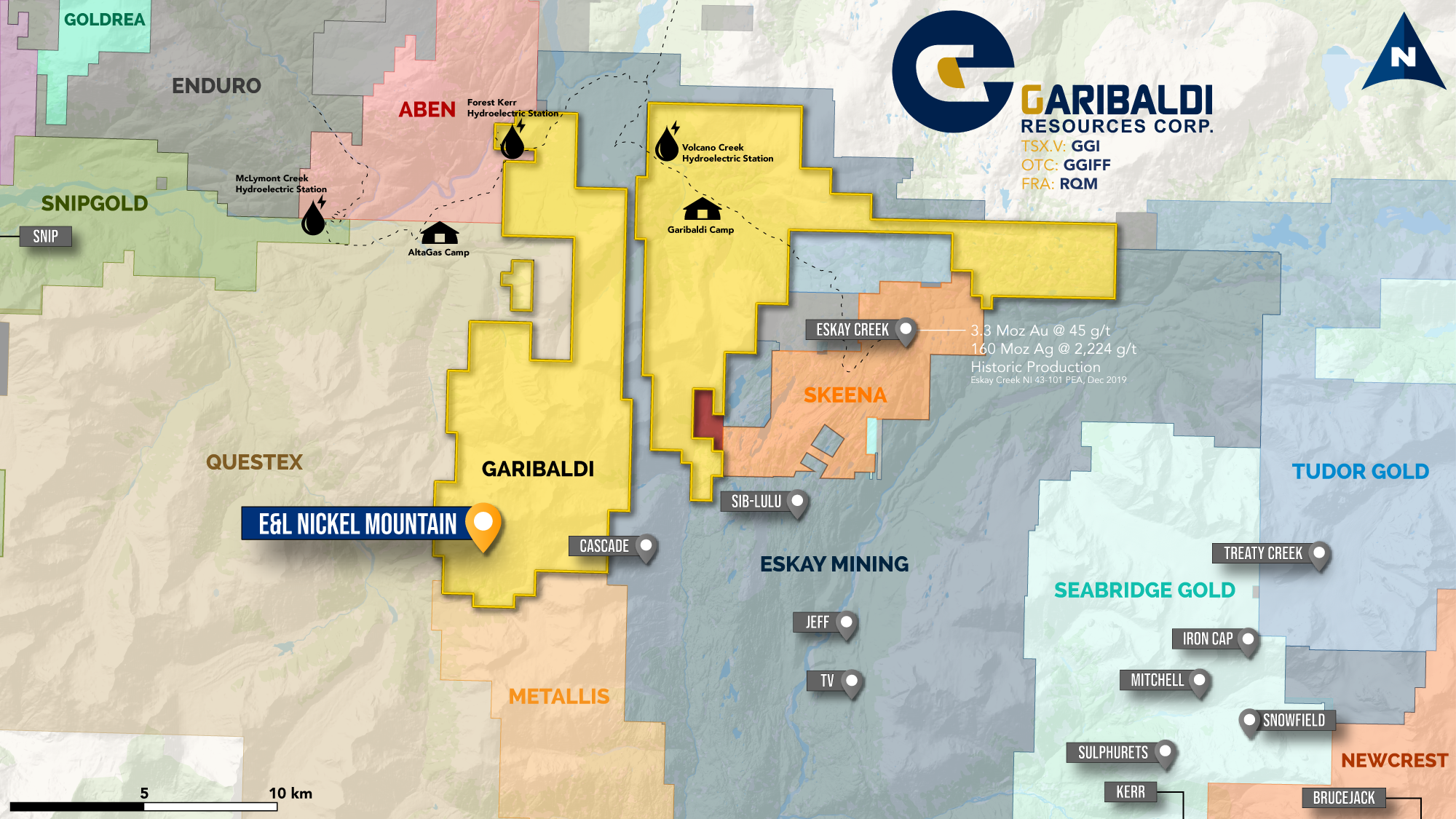
2022 ZTEM Survey Results
In 2021 Garibaldi conducted a deep penetrating ZTEM survey across the entire Nickel Mountain – PSP Claim block. The results of proprietary 3D inversion processing, has identified a large anomalous zone directly below, and continuous along trend with, the mineralized E&L gabbro confirmed from drilling. Most significantly, the large low resistivity ZTEM response (which corresponds to a weakly conductive signal) beneath the limits of drilling at E&L, is broad, continuous, and plunges directly below the nickel-copper-cobalt PGE bearing intrusion, which is host to numerous high grade massive sulphide lenses. This response along the keel of the E&L Intrusion is surprising in scale, with an east-west lateral extent exceeding 3km width and plunging over 2 kms to below the valley floor at the base of Nickel Mountain.
The center of the ZTEM response beneath E&L is located 400 m below the thickest portion of the mineralized differentiated Eastern extension of the E&L Intrusion, indicating where the mineral system may continue at depth. The up-plunge extent of the ZTEM anomaly daylights in the area of the West E&L targets, where mineralized boulders of E&L type gabbro with similar sulphide mineralization to E&L are associated with outcropping gabbros. The entire keel of the E&L Intrusion from West E&L along the plunge trend is untested and may be part of a bladed dyke in which mineralization was concentrated in multiple magma conduits.
The Large ZTEM response beneath E&L greatly expands the potential for further discovery beneath and around E&L. The survey also revealed numerous anomalous responses throughout the remainder of the property, many of which correspond to surface mineralization.
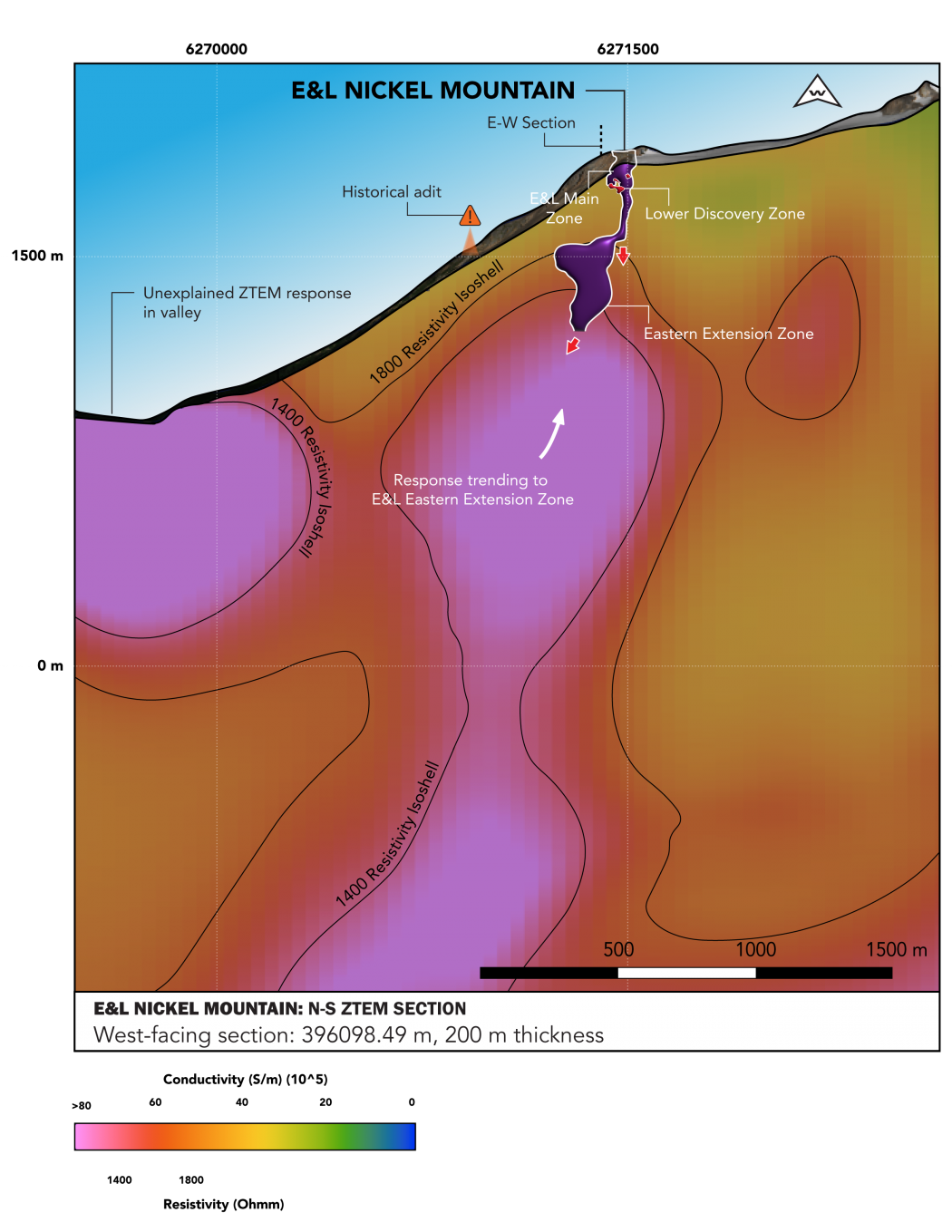
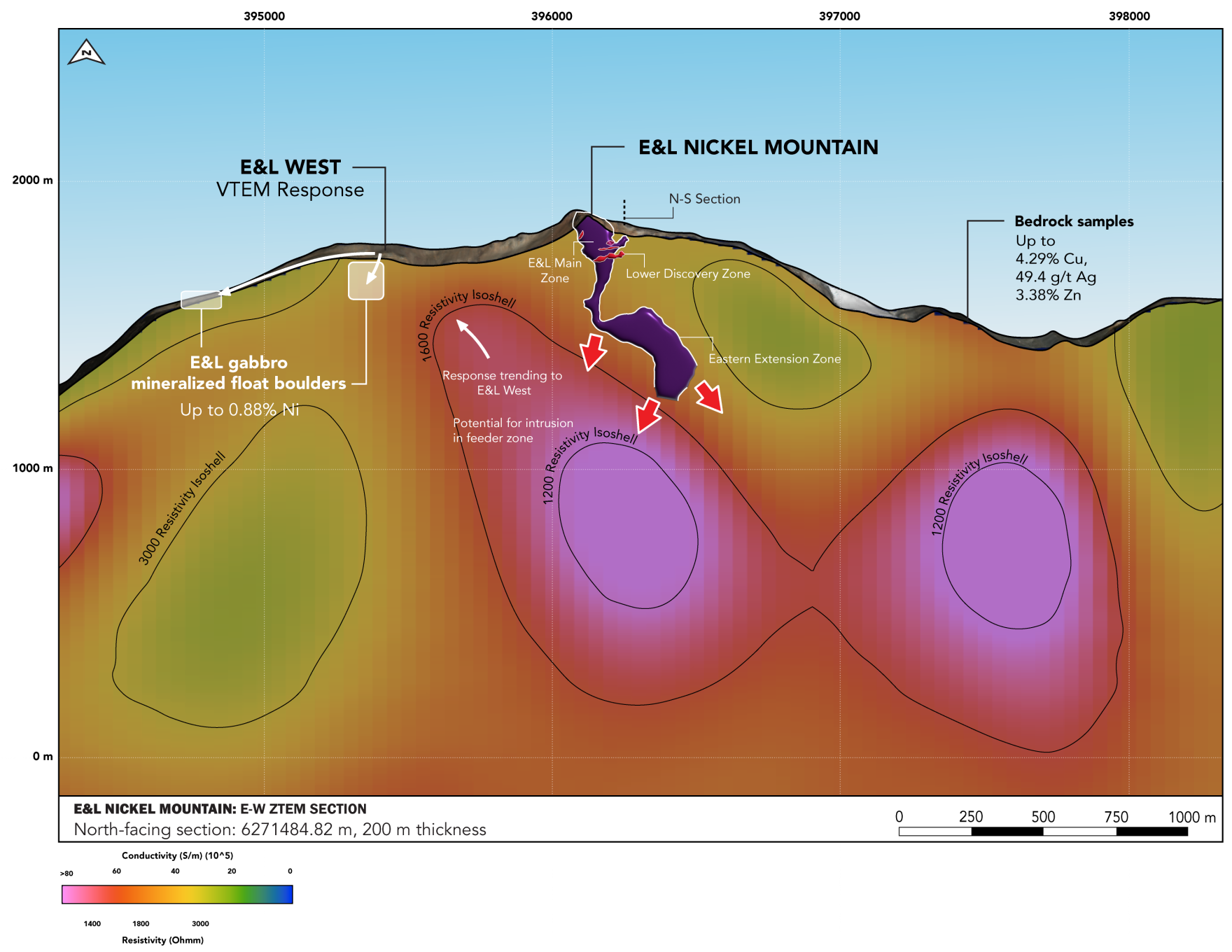
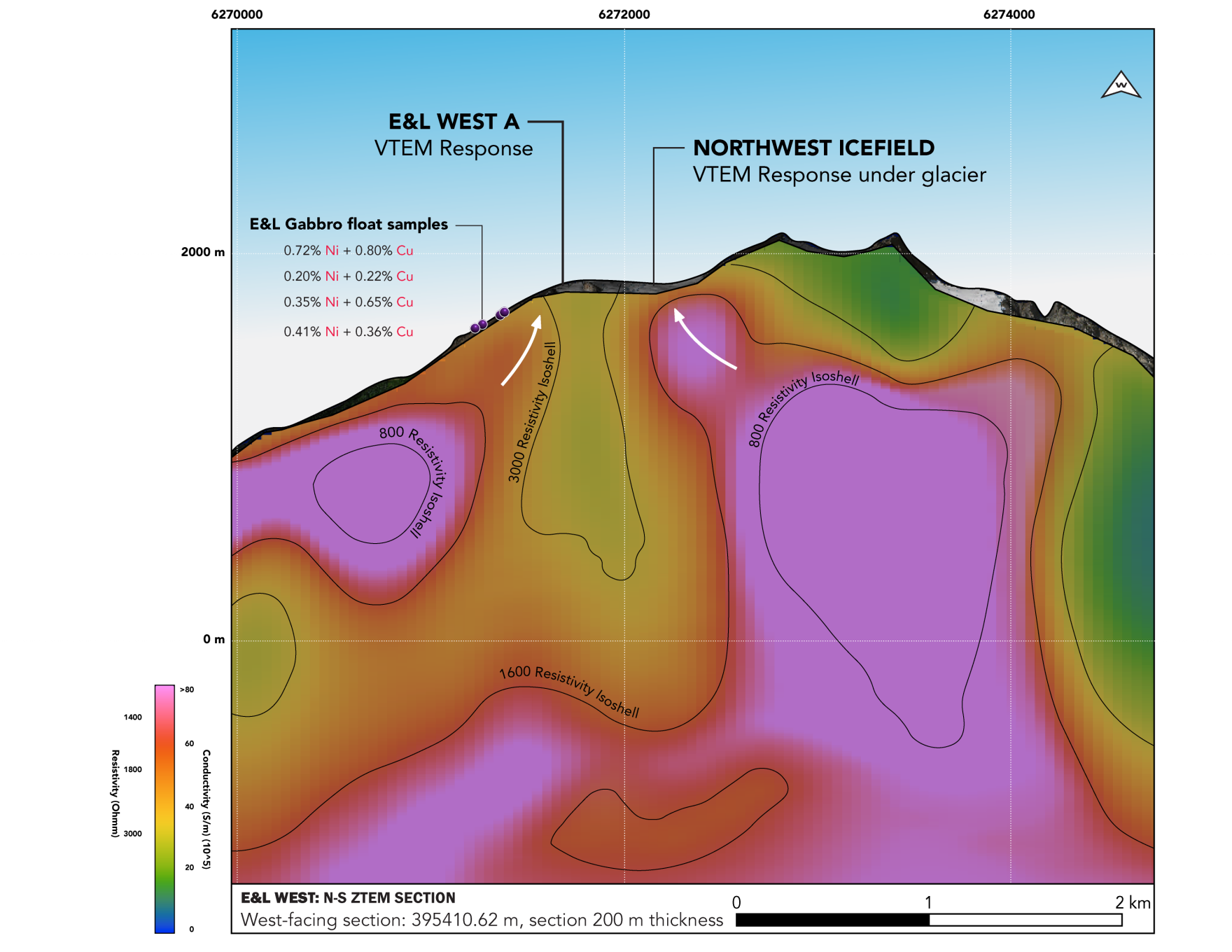
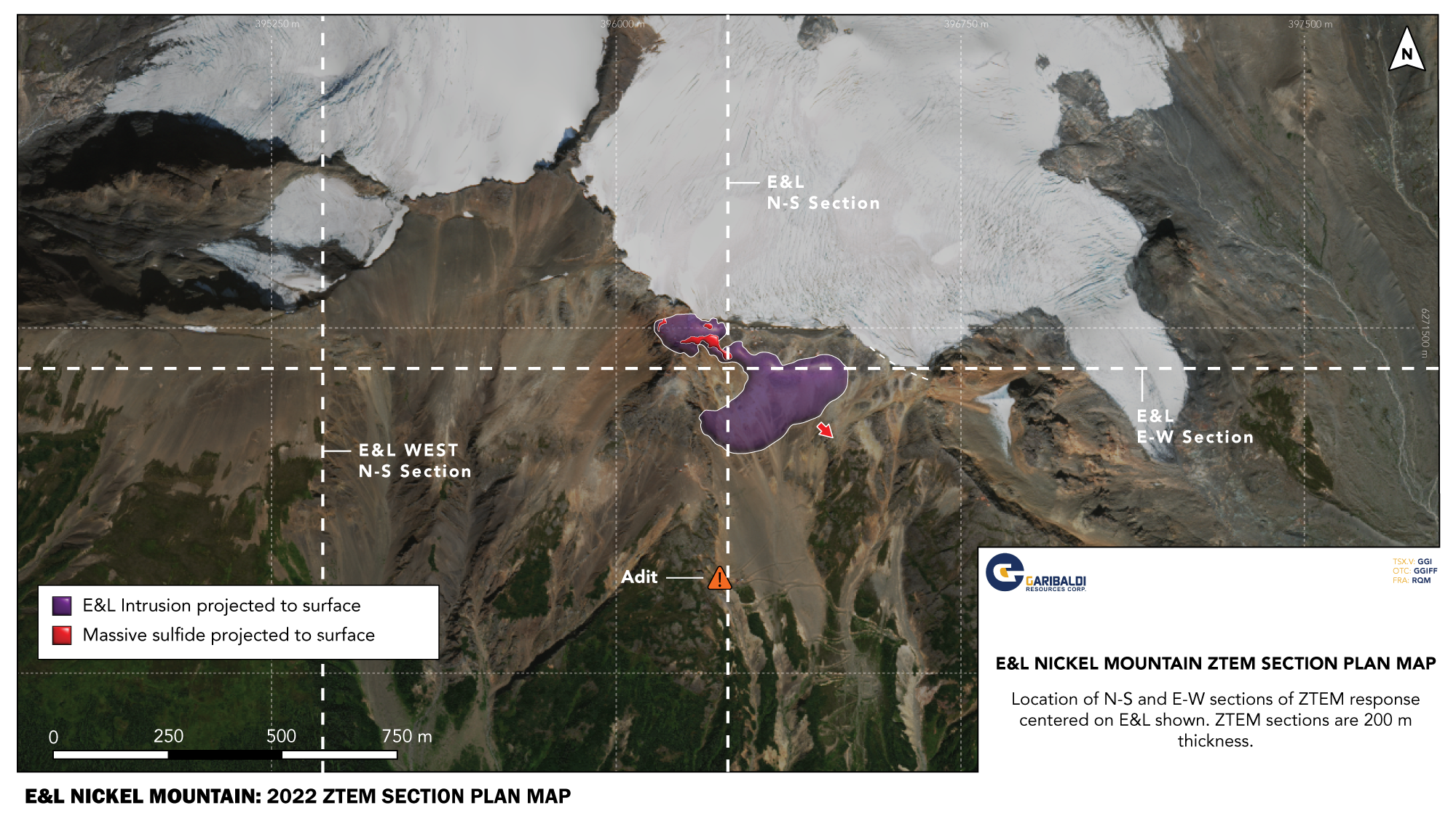
Geological Model of the E&L Intrusion
The configuration of the mineral zones in the Reid Brook Zone of the Voisey’s Bay Deposit provides an analogue for E&L. The below figure shows a N-S cross section of the Reid Brook Zone*, and highlights the development of massive sulfides in country rocks at the edge of a dyke-like intrusion which varies in width. The massive sulfides at Reid Brook, like those at E&L are devoid of inclusions and follow gently-dipping structures into the adjacent country rocks. The mineralization within the dyke at Voisey’s Bay is typically disseminated and interstitial sulfide as well as breccia-related mineralization, more akin to the style of disseminated mineralization in the chaotic taxitic olivine gabbros and orbicular-textured gabbros at E&L.
The plunge extent of the Reid Brook zone along the trend of the dyke may mirror to geometry of the E&L dyke, and it is quite possible that the lower heel of the E&L dyke widens out at depth into a much larger intrusion. In this light, the ZTEM feature beneath E&L is an exceptionally prospective target for further exploration.
The E&L Intrusion contains a very high proportion of sulfide relative to silicate, which is a characteristic feature of many open system magma conduits which form pipes and bladed-dykes. Relatively small intrusions are often endowed with large ore bodies, so the ZTEM target below E&L is especially important for the next phase of exploration.
Nickel Sulfide Ores and Impact Melts – Origin of the Sudbury Igneous Complex. 2017. Elsevier, Peter C. Lightfoot
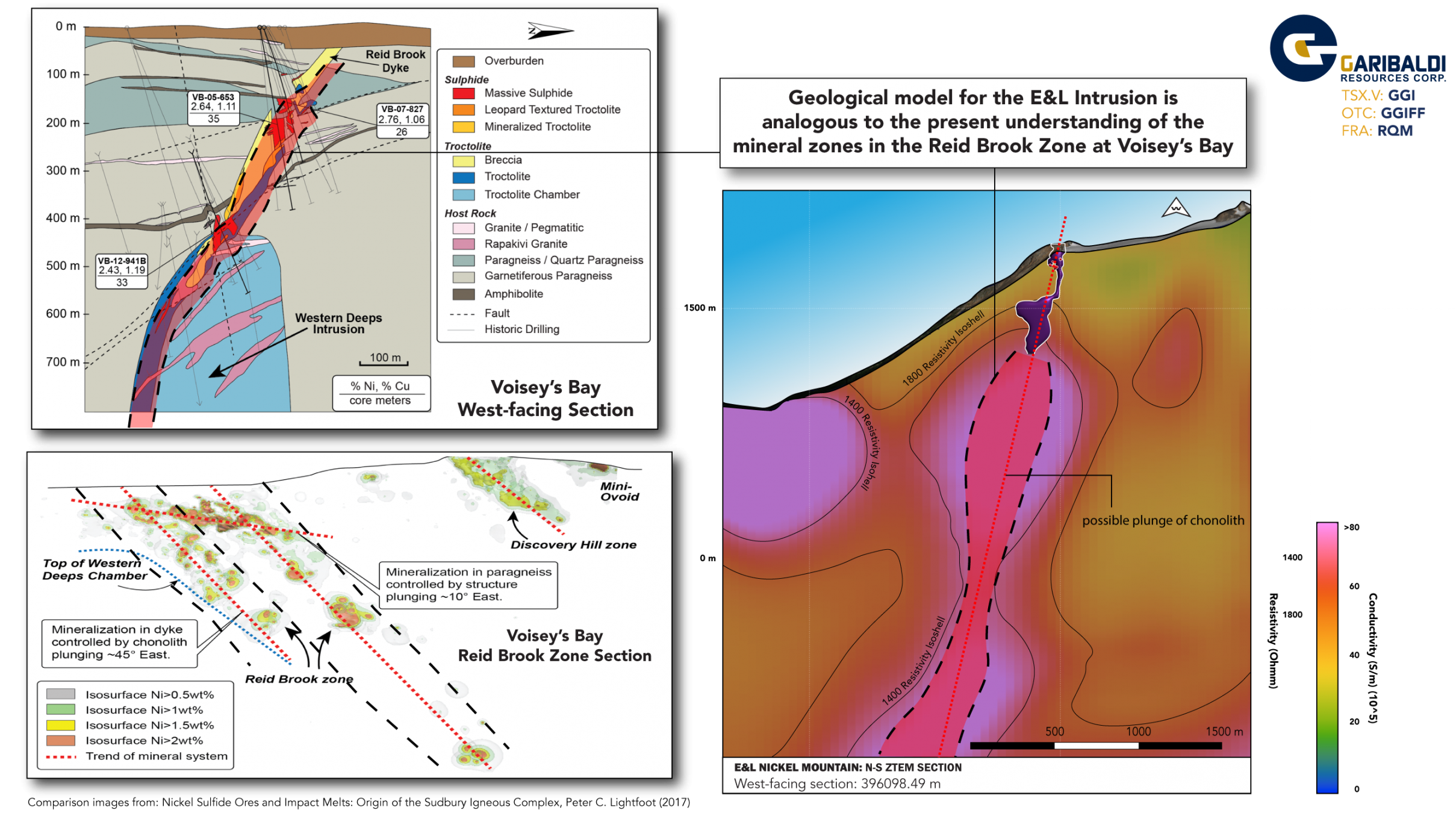
The Big Picture!
Dr. Peter Lightfoot, P.Geo., Technical Adviser for Garibaldi, commented: “Increasingly, Nickel Mountain represents an important new discovery within the Eskay Rift. The project is ideally positioned to leverage the demand from dramatically declining nickel sulphide discoveries and the resulting depletion of high quality nickel inventories required to fuel the electric vehicle battery revolution.”

